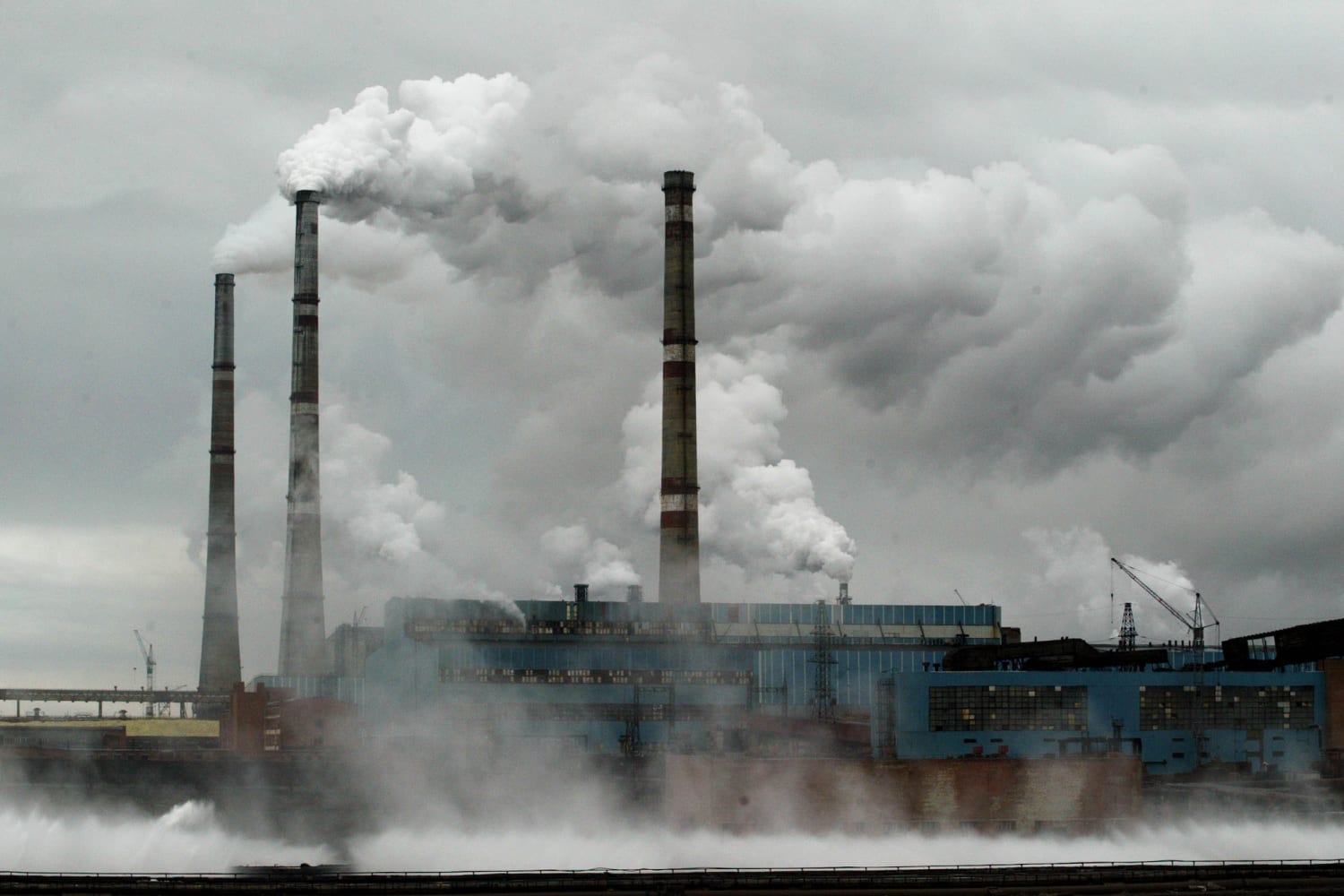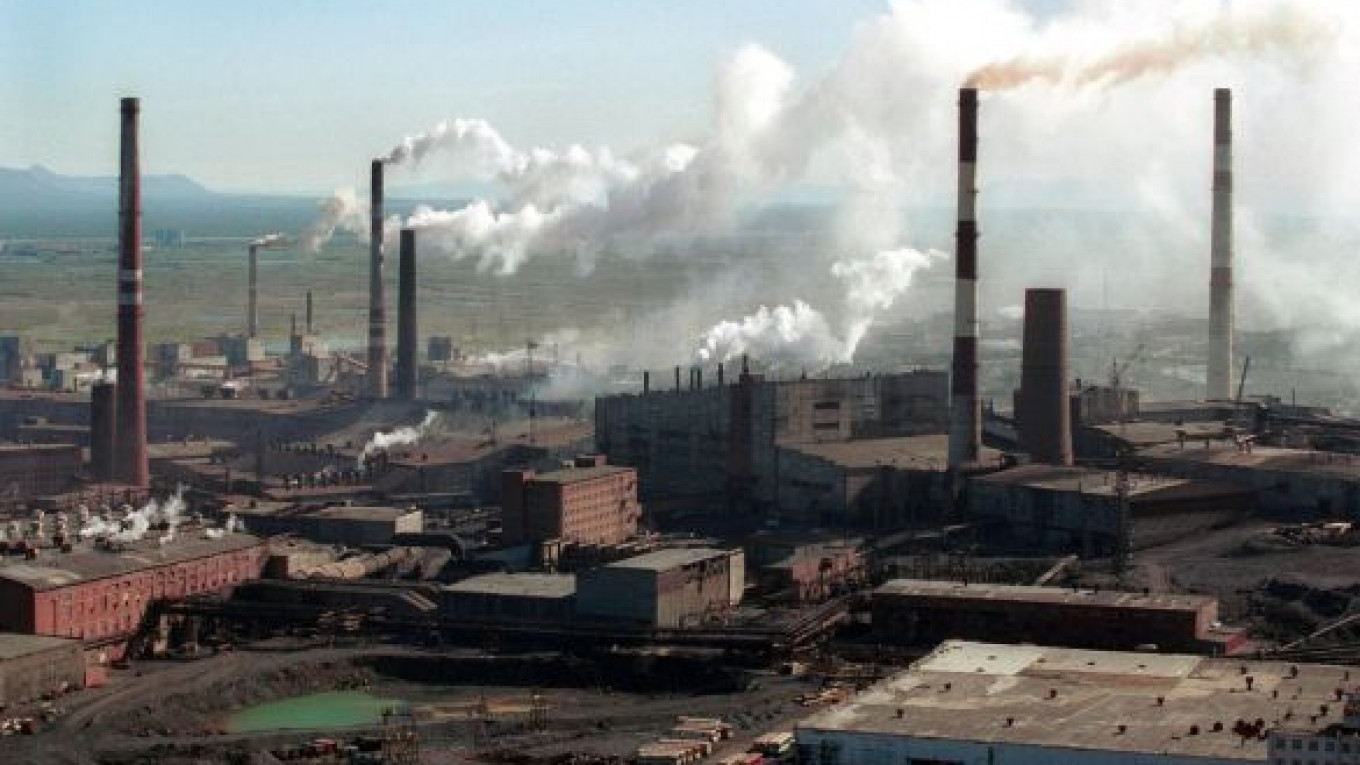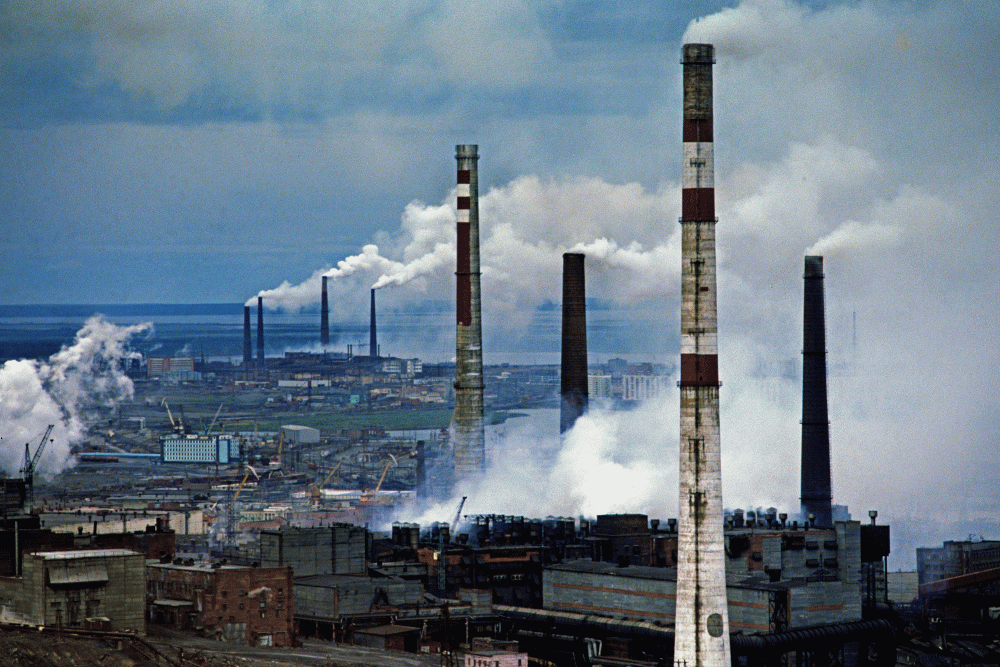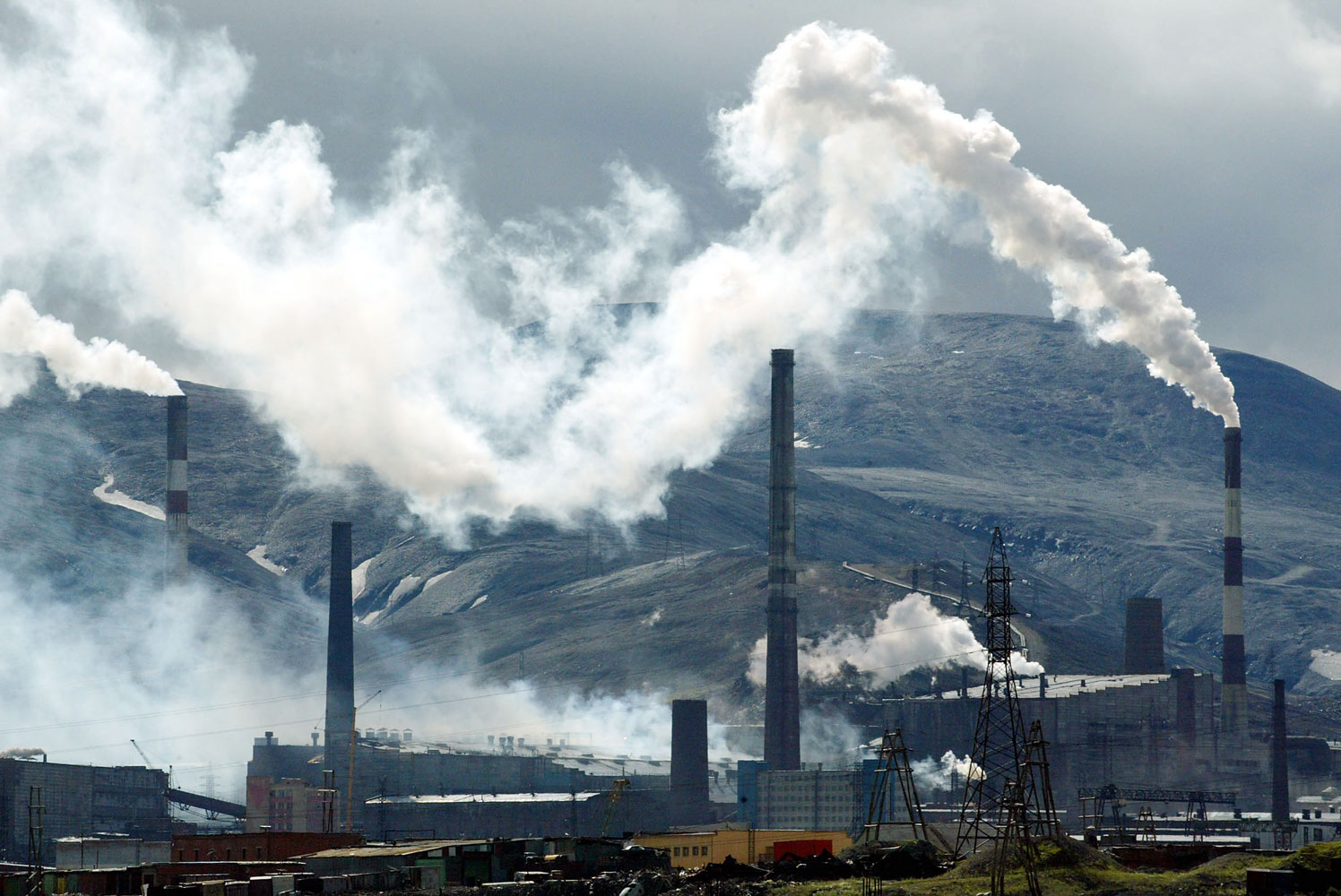- hot-spots
- air
- Russian Federation
- Air pollution in Norilsk, Russia

Problems
Norilsk is the northernmost city in the world with a permanent population of over 150,000 inhabitants. At the same time - one of the most «dirty» cities in Russia and the world. Norilsk is located in the north of the Krasnoyarsk Territory, south of the Taimyr Peninsula, about 90 km east of the Yenisei. In October 2021, Rosprirodnadzor named Siberia the most polluted federal district, and Norilsk the most environmentally harmful city in Russia. According to this rating, Norilsk leads by a wide margin: it produces 1875 thousand tons of pollutants per year (Cherepovets, which is in second place - 280 thousand tons, Novokuznetsk - 278 thousand tons).
Causes of air pollution in Norilsk, Russia
There are no analogs of the Norilsk industrial region (including the city) anywhere in the world. According to Roshydromet, Norilsk is included in the list of Russian cities «with the highest level of air pollution» (Priority List). The formation of a very high level of air pollution in Norilsk is due to significant emissions of sulfur dioxide, amounting to more than 1.9 million tons per year. According to the results of the analysis of air pollution indicators in the cities of the Arctic zone of Russia in 2015, the level of pollution in Norilsk is defined as «very high».
Gallery
4Timelines
2022
March 05
Mayor of Norilsk Dmytro Karasyov told at the Krasnoyarsk Economic Forum that last year a new division appeared in the city's administration - the Department of Ecology, and the implementation of several environmental protection programs began. In the rating of the dirtiest cities in Russia, published by the head of Rosprirodnadzor Svitlana Radionova in October 2021, Norilsk takes first place, followed by Cherepovets and Novokuznetsk. «Nornickel» presented the «Sulfur Program» at the Krasnoyarsk Economic Forum - a project for the utilization of sulfur dioxide at the Nadezhda Metallurgical and Copper Plants of the company's Polar Branch. As Andrii Bugrov, senior vice president for sustainable development of Nornickel, said, investments in the «Sirna program» should amount to about 300 billion rubles. The project has already started, 25% of the equipment has been delivered to the Nadezhda Metallurgical Plant, and workshops and gypsum warehouses are being built. The goal of the «Cheese Program» is to remove Norilsk from the ten dirtiest cities in Russia in a few years and make it a comfortable city with a high quality of life, Bugrov said. According to him, in 2016, in order to reduce sulfur dioxide emissions, he closed a nickel plant in Norilsk, which resulted in a reduction of pollution by more than 30%. In 2021, Norilsk-Taymyr Energy Company (a subsidiary of Nornickel) fully paid a fine of 146.2 billion rubles. for the fuel spill near Norilsk in May 2020. From this amount, 145400000000 rubles. went to the federal budget, and 684.9 million rubles. - To the budget of Norilsk. The sulfur project is under special control of the city, said the mayor of Norilsk Dmytro Karasyov. At the Nadezhda Metallurgical Plant, sulfur dioxide emissions should be reduced by 45% in 2023, and at the copper plant by 90% by 2026. This will significantly improve the quality of atmospheric air in Norilsk, says Karasyov. According to Karasyov, in 2021, Norilsk launched a new program for eliminating unauthorized landfills, keeping stray animals, greening Norilsk, and solving issues related to the circulation of municipal waste. In 2021, 17 hectares of landfills in Norilsk were liquidated, and 30 waste storage sites were created. One of the main problems of the city is the large number of abandoned and disassembled motor vehicles, says Karasyov. The city administration collects abandoned cars and moves them to special sites. The city is going to install shredders for the disposal of cars and their processing. In 2022, Norilsk is going to design a shelter for stray animals - this is important, because Norilsk is cut off from the Great Land, and captured animals cannot be released into the natural environment.
2021
April 15
Scientists from Novosibirsk at a meeting of the SB RAS announced an environmental catastrophe in Siberia. Director of the Institute of Atmospheric Optics of the Siberian Branch of the Russian Academy of Sciences Igor Ptashnik reported about two dozen Russian cities «with high and very high levels of atmospheric pollution.» About 80% of them are located in the Siberian Federal District. The scientist especially noted the Taimyr Autonomous Okrug, where Norilsk is located. The population there lives in conditions of high air pollution. Shock doses of benzopyrene, which has the strongest carcinogenic activity, are regularly emitted into the atmosphere. Among the dirtiest cities Ptashnik included Kyzyl, Abakan, Novokuznetsk, Norilsk, Krasnoyarsk. The report was not publicly available for long, it was quickly removed. According to Roshydromet, the level of air pollution in the cities of the Russian Federation in 2021 increased by 57% compared to 2019. The main pollutants were arsenic, zinc, iron, and nickel. In some areas, the presence of high levels of hydrogen sulfide, manganese, and oil products was noted. The most obvious sources of pollution are oil, metallurgical, and mining enterprises. Pulp and paper companies and housing and communal services also made a big contribution. Deputy Prime Minister Victoria Abramchenko at a meeting with the curators of the federal project «Clean Air» also named the dirtiest cities in Russia. Its statistics are slightly different from the information voiced by Siberian scientists. Chelyabinsk is in first place, Nizhny Tagil is in second, Magnitogorsk is in third, Norilsk and Novokuznetsk are in fourth, and Omsk is in fifth. The quality of air and water there leaves much to be desired. All of these settlements are the largest industrial centers. Chelyabinsk is home to metallurgical and machine-building enterprises. In Nizhny Tagil - metallurgical and chemical. Ferrous metallurgy and coal industry are developed in Novokuznetsk. The most problematic city, according to Abramchenko, is the capital of the southern Urals. According to Roshydromet, in the air of Chelyabinsk there is a systematic excess of the norms for benzopyrene, formaldehyde, phenol, nitrogen dioxide, fluoride, hydrogen sulfide, and suspended solids. According to the Ministry of Ecology of the Chelyabinsk Region, the amount of zinc, arsenic, lead, cadmium, manganese and copper in the city's soils exceeds the permissible limits. Local residents report that the city has turned into one big factory. If you are a bad housewife, you better not live in Chelyabinsk, jokes Galina Gorina, a resident of an industrial city. For three days, the window sill of a high-rise building is covered with black soot. Sometimes, as a joke, a woman writes her name with her finger before wiping the surface. Emissions from factories also end up on the floor, on furniture, even on clothes hanging in closets. Motorists do not part with a snow brush even in summer. Cars are covered with dust in just a day.
2019
November 29
Norilsk is the northernmost city in the world with a permanent population of over 150,000 inhabitants. At the same time - one of the most «dirty» cities in Russia and the world. The city-forming complex of Norilsk is the enterprises of the Russian mining and metallurgical company Norilsk Nickel. Norilsk traditionally falls into the list of the most polluted cities in the world. The level of atmospheric air pollution in Norilsk is consistently «very high». Moreover, the volume of emissions of this city with a population of two hundred thousand is more than twice the volume of emissions of a multimillion-dollar Moscow - 1959.5 thousand tons against 995.4 thousand tons per year. The leadership of Norilsk is also distinguished by the fact that its emissions are predominantly industrial in nature, while the share of automotive emissions is only 0.5%.
2017
October 19
The level of pollution in the Russian Arctic zone, according to the UN, is rapidly approaching the indicators of the Atlantic and Pacific oceans, where shipping is much more intensive. In some areas - both in the seas and in coastal zones - the environmental consequences of economic activity are obvious. Norilsk, located south of the Taimyr Peninsula, is one of the most polluted cities in the world. The volume of sulfur dioxide emissions into the atmosphere is 1.8 million tons per year. Norilsk is the northernmost city in the world with a permanent population of over 150 thousand people. Rosstat of Russia also recognized it as the most polluted city in the country. One of the main sources of pollution is the Norilsk Nickel mining and smelting plant and its numerous industrial sites. This is Mahir Aliyev, UN Environment Program Coordinator - UNEP for short. «Nickel production itself is a very polluting industry. The management of Norilsk Nickel is aware of this, and they understand that they must take some measures to reduce the level of pollution. We have been in contact with this company and they told us about a production improvement program they intend to launch in 2018 to reduce pollution by 80 percent, we were told.» The first stage of the program began last year - the Nickel Plant, one of the enterprises of the complex, was closed in Norilsk. Vladimir Zhukov, vice-president of the Norilsk Nickel mining and metallurgical company, told the UN News Service about this. «We closed the Nickel plant last year and also modernized the Talnakh concentrator. These were part of our larger program to modernize and reconfigure our processing assets in Norilsk. As a result, we expect that within the city of Norilsk, sulfur dioxide emissions should decrease significantly – we expect about 30 percent reduction.» According to experts, these measures are not enough. Norilsk Nickel's management is now considering several options for a «second stage» to improve the environmental situation in the region. «The project is very capital intensive and, depending on the option, it can cost up to $3.5 billion - this is according to the first option. The second option will cost a little less. Accordingly, the decision for the company is very large and responsible. We plan to accept it before the end of the year.» The history of Norilsk began in 1921, when members of an expedition to Taimyr discovered here the richest deposits of ores and metals. In 1935, the construction of the Norilsk Mining and Metallurgical Combine began. Today, its place has been taken by the industrial giant Norilsk Nickel, which is not going to curtail the mining and production of metals in the near future. Vladimir Zhukov speaking. «The company will continue to work in Norilsk for many decades, that is, if we take the service life of reserves and resources that are in the ground, and which are economically justified in terms of their extraction, it exceeds sixty years. Therefore, we have no plans to leave this region. Therefore, of course, we will work towards the gradual «cleansing» of the legacy that was left to us.»
2015
June 16
According to the Norilsk Monocity Modernization Plan, developed by the administration in 2013, more than 20.3 km of main collectors, which is 30% of the total length, have 100 percent wear and tear. The lower tiers of the collectors are flooded and silted up. Collapsed cable structures, as a result of which power and low-current cables lie at the bottom of silted or water-filled collectors. The operation of cable structures in conditions of high humidity led to their collapse, as a result, they ended up at the bottom of the collector in water and garbage. The annual amount of solid household waste (MSW) accumulated is 497,000 cubic meters. m, or 104 thousand tons. The rapid overflow of landfills due to the large volume and low density of placed waste leads to the formation of numerous unauthorized places of solid waste disposal. Lakes, which Taimyr was famous for not so long ago, now need protection. Sewage discharges into rivers harmed their inhabitants, and some lakes simply turned into a reservoir for industrial waste. In windy weather, the fresh Arctic wind of the tundra ventilates the city, so fog is almost never formed in Norilsk. But dangerous emissions do not belong to the ice of the Arctic Ocean, but settle near the city on the surface of vulnerable and vulnerable tundra and forest tundra. In the Modernization Plan of the Monocity of Norilsk (2013), the main goal is to ensure a stable economic state of the city, which can be achieved by preserving the production potential of the main city-forming enterprise. Based on this goal setting, it can be concluded that the city government will continue to direct its efforts primarily to the economic growth of the city, and not to the preservation of the environment.
2009
September 22
The largest source of pollutant emissions is the Arctic branch of «Norilsk Nickel» (2 million tons), enterprises of the Krasnoyarsk region, as well as stationary sources of Kemerovo (1.3 million tons) and Irkutsk (0.5 million tons) regions.
2007
July 18
The environmental situation in Norilsk is one of the most pressing topics. Every spring, as soon as the sky above the northern city becomes a little lighter, we see heavy plumes of poisonous smoke, which sometimes covers the city with a gloomy cap, then stretches somewhere into the tundra, leaving behind a wide strip of dead land. An interesting detail noted by the British is that every day the Norilsk Metallurgical Plant makes an invaluable contribution to preserving clean air on earth. Yes, do not be surprised. This is true. Palladium, which is produced in Norilsk, is widely used for the manufacture of automotive catalytic converters. In case anyone doesn't know, this device helps reduce the damage that car exhaust does to the world's atmosphere. And here is the paradox: while helping the world to preserve clean air, the Norilsk metallurgical industry emits a huge amount of sulfur dioxide into the atmosphere every day, turning Norilsk into one of the dirtiest cities on the planet. And all the promises of the NN management to reduce emissions remain empty words, at least until Nornickel itself exercises control over the ecological situation in the city. So far, the ecology of Norilsk remains only a talk in favor of the poor, and the city is covered by toxic clouds every day. In the summer, they turn into acid rains, and, by the way, Norilsk, with its stingy climate for showers, remains the champion in terms of the amount of these rains. This is how we fulfilled the corporate order a long time ago — we reached world leadership. ... The feasts of the Saints of «Hope» are huge raging cauldrons. Giant furnaces melt the ore mined in the mines and sometimes spew bright red streams of molten metal into containers that dwarf the workers standing next to them. Here they produce a mixture that includes nickel, copper, palladium, platinum, gold and silver. The ore also contains a large amount of sulphur.' What part of this sulfur enters the air through the pipes of NMZ? Unfortunately, this secret is not even under seven seals. This information is classified by the Polar Branch and is not released to the media. However, this is not necessary. It is enough to look at the wide openings, which were paved by plumes of poisonous smoke. They are clearly visible in the summer - strips of burnt earth go far beyond the horizon, not a single blade of grass grows there, a poisoned brown river flows through these dead streams, whimsically twisting. In winter, the smoky path is pleasing to the eye - red and yellow snow lies in stripes in the white tundra. This is our twilight zone, in terms of color and sharpness of impressions, it can be compared only, probably, to the Chernobyl exclusion zone. We have enough of such twilight zones - a strip of smoke-scorched, dead tundra lies around the Kayerkan - Norilsk road. This is Nadiya's contribution to the killing of the Arctic. The land around the copper plant is generally more like a synthetic embankment. Here are really glass rivers, iron banks.
2003
According to the response of Roshydromet to the relevant Greenpeace request, «due to the emergency state of the premises in which the complex laboratory of Norilsk was located, no monitoring of environmental pollution in the city is carried out.» The court ordered the environmental control authorities of Norilsk to create a laboratory for monitoring environmental pollution for 80 million rubles.


